
Salvia sclarea, the clary or clary sage, is a biennial or short-lived herbaceous perennial in the genus Salvia. It is native to the northern Mediterranean Basin, along with some areas in north Africa and Central Asia. The plant has a lengthy history as a medicinal herb, and is currently grown for its essential oil.

Salvia mellifera is a small, highly aromatic, evergreen shrub of the genus Salvia native to California, and Baja California, Mexico. It is common in the coastal sage scrub of Southern California and northern Baja California. Black sage has a dark appearance, especially during drought.
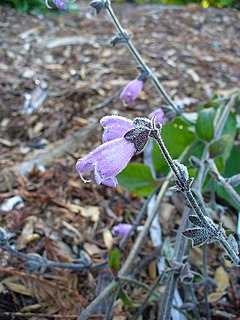
Salvia hians is a mound-forming perennial, native to the Himalayas from Pakistan to Bhutan. It is common in Kashmir, growing at 2,400 to 4,000 m on open slopes and forests. The plant was described in 1830 by John Forbes Royle, a British botanist living in India who studied the medicinal properties of Himalayan plants.

Salvia pratensis is a species of flowering plant in the family Lamiaceae, native to Europe, western Asia and northern Africa. The specific epithet pratensis refers to its tendency to grow in meadows. It also grows in scrub edges and woodland borders.
Salvia sprucei is a herbaceous perennial in the Lamiaceae family that is native to Ecuador, growing at 7,000 feet (2,100 m) elevation or higher in thick scrub on steep slopes. It was named in 1898 by botanist John Isaac Briquet for the British plant collector Richard Spruce. It is likely that Spruce discovered the plant on a collecting trip in Ecuador in 1857.
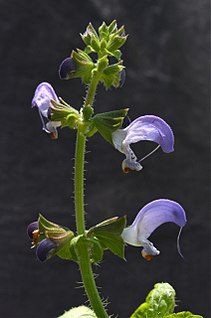
Salvia algeriensis is an annual Salvia native to northeast Morocco and northwest Algeria, found growing at up to 600 m (2,000 ft) elevation. In its native habitat, it grows nearly 1 m (3.3 ft) in height, with bright green ovate leaves about 8 cm (3.1 in) long and wide. Each plant produces 3-4 inflorescences up to 15 cm (5.9 in) long, with light violet flowers that have violet specks on the lower lip. The plant has a light scent when crushed, similar to thyme.

Salvia brandegeei, the Santa Rosa Island sage or Brandegee's sage, is a perennial evergreen shrub that grows to 3–4 feet in its native habitat. For many years, it was thought to be native only to Santa Rosa Island, one of the Channel Islands of California. In the 1960s and 1970s six colonies were found in Baja California. In cultivation, the plant will reach 4–5 feet tall and up to 7 feet (2.1 m) wide. It has dark green scalloped leaves, about 3-4 inches long and 0.5 inch wide. The pale lavender flowers are about 0.5 inch long, in tightly spaced whorls. The violet-gray calyx, combined with the wide open flower lips, make it a very showy flower.
Salvia candidissima is a herbaceous perennial native throughout western Greece, and parts of Turkey, Iraq, and Iran, generally between 2000 and 6500 feet elevation. Several small stems grow almost horizontally from the roots before bearing upright inflorescences. The plant reaches 3 ft in height and width in the wild. The light green leaves, 6 in long by 4 in wide, are covered with hairs on both sides and often have notches on the edges. The leaves become lighter in color as the weather gets hotter. The 8–12 inch inflorescences are branched, with 1 inch flowers in whorls that are creamy white and sometimes tipped with a yellow lip. Salvia candidissima is one of a group of seven salvias that are closely related, grow in the same habitat, and easily hybridize with each other, resulting in a great deal of variety in the species.

Salvia karwinskii is a perennial shrub native to the moist mountain forests of Mexico, Guatemala, Honduras, El Salvador, and Nicaragua, typically growing in or near pine or oak forests at 4,000 to 8,000 feet elevation. It is known as a honey-producing plant in those areas, but is rarely seen in private gardens. Specimens are grown at Strybing Arboretum, Huntington Botanical Gardens, and University of California Botanical Garden.
Salvia littae is a herbaceous perennial native to the Mexican state of Oaxaca, growing at elevations of 8,000-10,000 feet. The plants typically grow in some shade in groups at the edge of moist oak forest, or cloud forest.
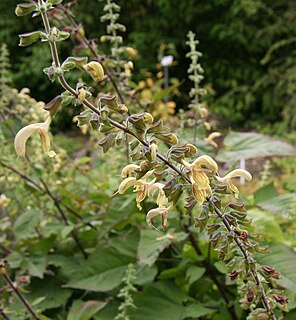
Salvia nubicola is a herbaceous perennial native to a wide region that includes Afghanistan, Bhutan, India, Pakistan, southwest Asia, and Europe. The plant grows at elevations of 2,000 to 4,300 m in dry forests, often with Pinus wallichiana, typically growing in large colonies in woodland clearings. It is especially common in the Muktinath Valley, and is used in traditional Tibetan medicine.

Salvia recurva is a woody-based perennial native to the cloud forests of Central America, limited to the northern slopes of Oaxaca, Chiapas, and Guatemala at elevations around 10,000 feet (3,000 m). It grows where there is year-round warmth and abundant moisture in the air and on the forest floor. Salvia recurva was described by George Bentham in 1848, with the specific epithet referring to the distinct curve in the inflorescence when it first appears.
Salvia rypara is a herbaceous perennial native to Argentina and Bolivia—due to its being very adaptable it is reported to be naturalized in Mexico and possibly Central America. It prefers stream bank habitats, as the specific epithet rypara implies. It also grows in weedy thickets, thriving at elevations under 3,000 feet. Described by John Isaac Briquet in 1896, it is not very well known in horticulture, with only a few gardeners growing it since the 1990s. It is becoming more well known in the United States, France, England, and Italy because it is easy to grow and makes a very attractive garden plant.
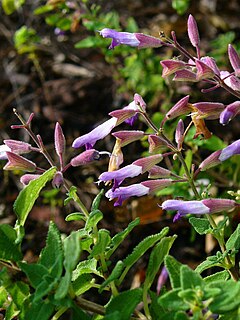
Salvia semiatrata is a perennial native to the Sierra Madre del Sur in the Mexican state of Oaxaca, growing at elevations of 6,500 ft (2,000 m) or higher. It prefers the edges of pine forests, and is also found on limestone cliffs and banks and in cactus scrub habitats that are dry and exposed.
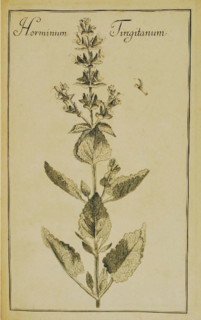
Salvia tingitana is an herbaceous perennial in the family Lamiaceae. It has a long and enigmatic history—it has been grown and described since the 17th century without any certainty about its origin. Botanists' speculation that it was native to northern Africa is reflected in the specific epithet tingitana, which refers to the town of "Tingi", even though no native plants have ever been found there. It was not until 1989 that a wild population of the plant was discovered, in western Saudi Arabia.
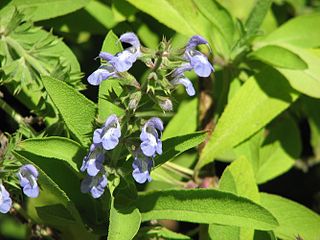
Salvia somalensis is a perennial shrub endemic to a limited range and elevation in Somalia. It grows at elevations from 4,000 feet (1,200 m) to 7,000 feet (2,100 m), typically in forest clearings or edges as a common or dominant subshrub.
Salvia villosa is a herbaceous perennial that is native to the Mexican states of San Luis Potosi and Coahuila, growing at approximately 4,000 feet (1,200 m) elevation in dry areas that have little or no frost.
Salvia thermarum is a perennial native to South Africa, discovered in 1998 by Ernst van Jaarsveld of Cape Town's Kirstenbosch National Botanical Garden. The common name is based on the location of the plant's discovery, near Goudini Spa, approximately 120 km from Cape Town—the specific epithet, thermarum, refers to the thermal baths where it was found. It is only found native in the Cape Provinces.
Salvia personata is an annual herb that is native to valleys and foothills in the Andes of Bolivia and northern Argentina. It grows in disturbed bushy habitat at 600 to 2,600 m elevation.
Salvia herbanica is a critically endangered perennial plant that is endemic to the Canary Islands, growing in the mountains of southern-central Fuerteventura, at 250 to 400 m elevation. In 2004 there were only 212 known plants in the wild, in ten locations, with fewer than 50 plants in each location. Habitat for the plant continues to shrink due to predation by herbivores. Less than 50 of the plants are safe from predation, with the rest of the plants in poor health.













